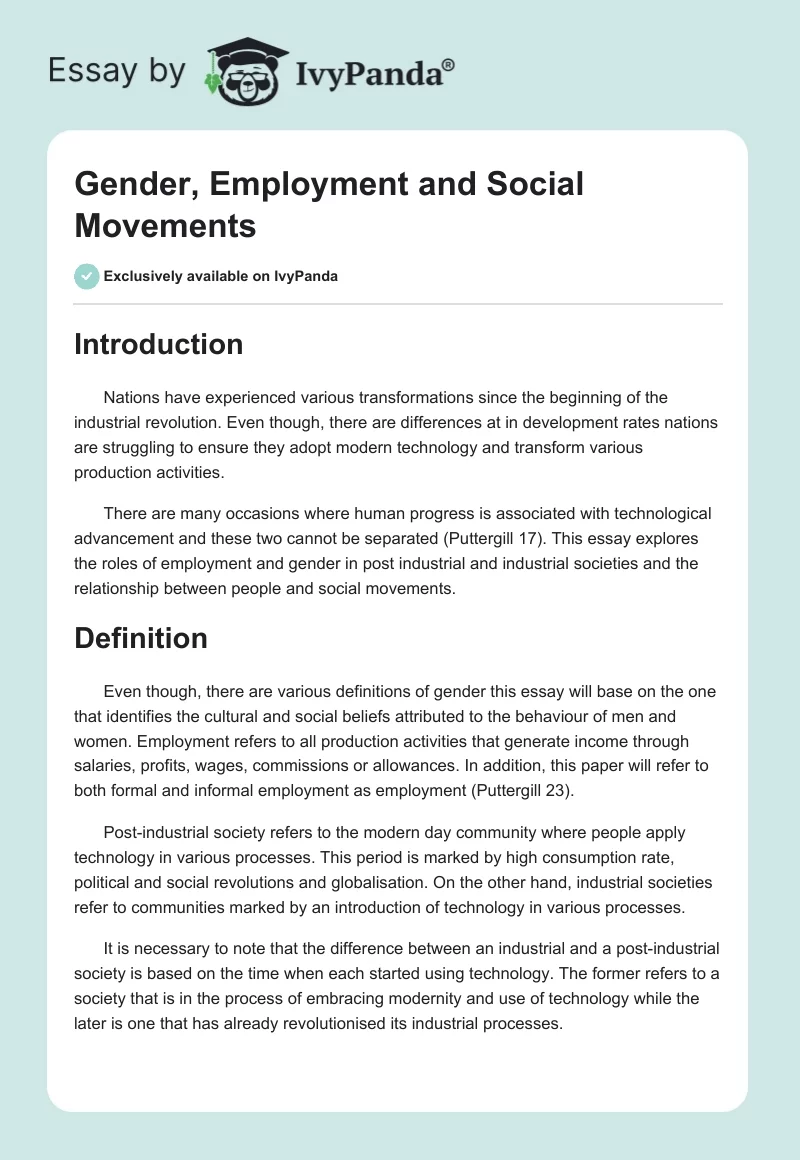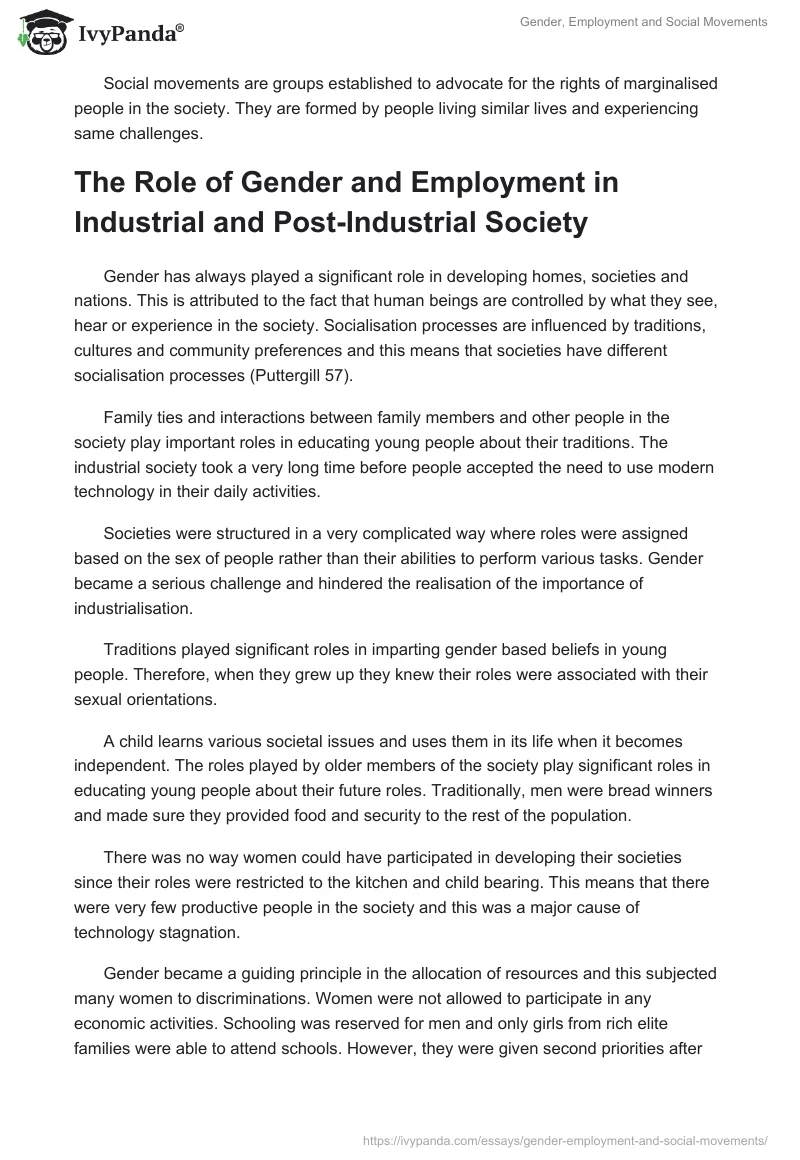Introduction
Nations have experienced various transformations since the beginning of the industrial revolution. Even though, there are differences at in development rates nations are struggling to ensure they adopt modern technology and transform various production activities.
There are many occasions where human progress is associated with technological advancement and these two cannot be separated (Puttergill 17). This essay explores the roles of employment and gender in post industrial and industrial societies and the relationship between people and social movements.
Definition
Even though, there are various definitions of gender this essay will base on the one that identifies the cultural and social beliefs attributed to the behaviour of men and women. Employment refers to all production activities that generate income through salaries, profits, wages, commissions or allowances. In addition, this paper will refer to both formal and informal employment as employment (Puttergill 23).
Post-industrial society refers to the modern day community where people apply technology in various processes. This period is marked by high consumption rate, political and social revolutions and globalisation. On the other hand, industrial societies refer to communities marked by an introduction of technology in various processes.
It is necessary to note that the difference between an industrial and a post-industrial society is based on the time when each started using technology. The former refers to a society that is in the process of embracing modernity and use of technology while the later is one that has already revolutionised its industrial processes.
Social movements are groups established to advocate for the rights of marginalised people in the society. They are formed by people living similar lives and experiencing same challenges.
The Role of Gender and Employment in Industrial and Post-Industrial Society
Gender has always played a significant role in developing homes, societies and nations. This is attributed to the fact that human beings are controlled by what they see, hear or experience in the society. Socialisation processes are influenced by traditions, cultures and community preferences and this means that societies have different socialisation processes (Puttergill 57).
Family ties and interactions between family members and other people in the society play important roles in educating young people about their traditions. The industrial society took a very long time before people accepted the need to use modern technology in their daily activities.
Societies were structured in a very complicated way where roles were assigned based on the sex of people rather than their abilities to perform various tasks. Gender became a serious challenge and hindered the realisation of the importance of industrialisation.
Traditions played significant roles in imparting gender based beliefs in young people. Therefore, when they grew up they knew their roles were associated with their sexual orientations.
A child learns various societal issues and uses them in its life when it becomes independent. The roles played by older members of the society play significant roles in educating young people about their future roles. Traditionally, men were bread winners and made sure they provided food and security to the rest of the population.
There was no way women could have participated in developing their societies since their roles were restricted to the kitchen and child bearing. This means that there were very few productive people in the society and this was a major cause of technology stagnation.
Gender became a guiding principle in the allocation of resources and this subjected many women to discriminations. Women were not allowed to participate in any economic activities. Schooling was reserved for men and only girls from rich elite families were able to attend schools. However, they were given second priorities after boys in terms of provision of school amenities, fees and other personal items (Puttergill 71).
This means that there were very few skilled people in the society and this became a major setback in developing their countries. Education offers people opportunities to explore their skills, talents and abilities and use them to develop their homes, communities and nations. There were many unemployed people in these societies since a handful of men were willing to allow their women and daughters to engage in productive activities.
This high dependency ratio meant that there were no funds for development projects. Most people survived from hand to mouth due to the high number of unemployed people in their families. A nation that has a large working population has enough funds to finance other development projects. However, gender beliefs locked many women out of employment opportunities either by choice or default.
Gender beliefs have significantly affected women in industrial societies since it has been perpetuated by both men and women. Some societies consider women to be servants and deny them opportunities to school or participate in business activities. Even though, men have played significant roles in enhancing gender stereotypes women have also played active roles in perpetuating this vice.
The post industrial society has experienced significant transformations in terms of gender stereotypes and other traditional beliefs. The industrial era was transformed by affirmative actions by various social movements to ensure women were given active roles in developing their societies. Affirmative action means all deliberate efforts to ensure that all marginalised groups were given opportunities similar to those given to other groups.
It is important to understand that marginalised groups include women, disabled, children, old people and those that belong to minority groups (Puttergill 98). Most traditions considered women to be weak and unable to perform roles that men performed. In addition, youths, old and disabled people were discriminated against in terms of leadership positions since the society considered them unable to perform their duties effectively.
However, the post-industrial societies have experienced major transformations in employment, education and leadership. These were key issues that influenced social progress and since they were addressed through affirmative actions the society was ready to listen to them.
Post-industrial societies are characterised by a decrease in gender stereotypes which open ways for social, political and economic developments. These societies have many learning institutions since boys and girls are given similar opportunities to go to school and shape their future. Most parents have realised that all children are equal irrespective of their sexual orientations.
This means that both boys and girls must be given equal opportunities at school, home and work place. The belief that women could not handle some careers like engineering or accounting is long gone and people are giving women opportunities to venture in different careers. This has enabled more women to attend high schools, colleges and universities and engage in productive activities.
In addition, the job market has been flocked by professional women who are more aggressive and committed to work than some men (Puttergill 62). People in post-industrial societies have realised that issues of development are based on intelligence, commitment, transparency, accountability and willingness to perform duties.
This has made modern societies to develop very fast as more women are given opportunities to explore their abilities. The unity between men and women has played significant roles in ensuring they handle societal challenges without basing their roles on gender issues.
Modern societies have frameworks that enable women to participate in politics, management and leadership positions that were traditionally kept for men regardless of whether or not they were qualified, ready or committed to handle their roles.
Social Movements
The Social Network Theory is an important hypothesis used to explain the roles of social movements and groupings. This theory proposes that human interests are important in establishing relationships amongst people. However, there exists personal difference that may hinder interactions between people (Puttergill 103).
This theory proposes that these differences are usually overlooked when it comes to formation of social movements. It explains that people have personal and collective problems and must develop way of handling them either within groups or as individuals.
Therefore, people come together and devise ways of handling their communal problems. The most effective way of doing this is by forming social movements that are used as vehicles to advance their needs. Even though, individual differences exist within a population people are usually motivated by communal challenges to form social movements. This theory explains that people are like entities connected by collective challenges.
All personal differences are put a side when forming these movements. A good example is a political party, religious group, professional unions and private groups. People must remain in social movements provided they want their needs to be addressed by relevant authorities (Puttergill 117). Some issues can only be raised through these movements since some states consider any external agitation as incitement.
For instance, affirmative actions are usually advanced by no governmental organisations that are constitutionally allowed to stage demonstrations to demand equality and justice in various fields. However, when individuals attempt to do this it may seem like a public nuisance and this may attract legal actions against them.
On the other hand, people leave these movements because of three reasons. First, some movements are formed to advance short term gains and they are abolished once their intentions have been realised. For instance, people can form a movement to compel their state to implement a policy and after this it becomes irrelevant; therefore, it must be abolished (Puttergill 191).
A movement can be declared illegal if its objectives contravene constitutional requirements. Some movements may be formed because of advancing political gains at the expense of innocent civilians. Some of them may be perpetuating vices like Satanism, child abuse and discrimination.
Therefore, they must be abolished once the state discovers that their operations are illegal. Lastly, people can leave their movements once they realise they are not helpful in advocating for their needs. Inactive movements have reason to exist and people cannot waste their time and resources in them since they are unproductive.
Conclusion
Gender stereotypes played significant roles in hindering development during the industrial era. However, affirmative actions have made the post-industrial society liberal and ensure men and women are given equal opportunities in the society. Social movements have become common ways of advancing societal needs, fighting gender stereotype and compelling governments to perform their roles effectively.
Works Cited
Puttergill, Charles. Group Dynamics. Only Study guide for SOC306B. Pretoria: University of South Africa, 2001. Print.


